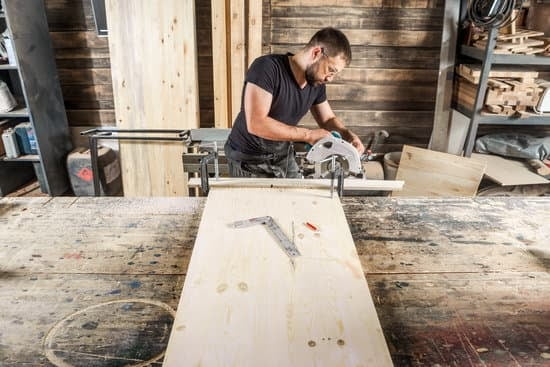When it comes to woodworking, having the right tools can make all the difference in the quality and precision of your work. One tool that every woodworker should have in their arsenal is a woodworking sector tool.
This versatile instrument is essential for measuring, marking, and producing accurate angles and proportions in woodworking projects. In this article, we will guide you through the process of making your own woodworking sector tool, ensuring that you have a reliable and customized tool at your disposal.
The functionality of a woodworking sector tool lies in its ability to accurately measure and transfer angles. It consists of two arms connected by a pivot point, allowing for easy adjustment to find precise measurements for various lengths and angles. Woodworkers use this tool to determine dimensions, mark out lines, create symmetrical designs, evenly space objects, and much more.
By making your own woodworking sector tool, you can tailor it to suit your specific needs and preferences. Whether you’re a beginner looking to expand your collection of tools or an experienced woodworker searching for a customizable option, crafting your own sector tool allows you to have complete control over its design and accuracy.
With our step-by-step instructions and expert advice, you’ll be able to create a precise and reliable sector tool that will elevate your woodworking projects to new heights.
In the next sections of this article, we will delve into the basics of a woodworking sector tool, provide a list of essential materials needed for its construction, offer detailed guidance on its fabrication process with safety measures included. We will also share some valuable tips and tricks from seasoned woodworkers along with advice on finishing and testing the accuracy of your newly made sector tool.
Additionally, we’ll explore alternative options available in case making one from scratch doesn’t suit your needs. Finally, we’ll touch upon maintenance and care tips to ensure that your woodworking sector tool remains in optimal condition for years to come.
Get ready to embark on this rewarding journey of creating your own woodworking sector tool that will enhance the precision and effectiveness of your woodworking projects.
Understanding the Basics of a Woodworking Sector Tool
A woodworking sector tool is a versatile and essential instrument used in woodworking for measuring and transferring angles accurately. It consists of two straight arms connected by a hinge or pivot point, forming an L-shape when opened.
The main purpose of a sector tool is to quickly and precisely divide a line or angle into equal parts. Woodworkers use this tool for tasks such as marking out mortise and tenon joints, drawing arcs, finding or setting angles, and creating proportional measurements.
Components of a Woodworking Sector Tool
A typical woodworking sector tool consists of the following components:
- Arms: The two arms of the sector tool are usually made from wood or metal and are hinged together at one end.
- Hinge or Pivot Point: This allows the arms to move freely while maintaining their relative position.
- Graduations: One arm usually has graduations marked along its length, allowing precise measurements to be taken.
- Scribe Point: The opposite end of one arm is pointed or marked with a scribe point for accurate marking on surfaces.
Working Principle
The working principle behind a woodworking sector tool relies on the mathematical ratios between different sides of similar triangles. By opening the arms to achieve specific ratios, woodworkers can divide lines or angles into equal parts easily without complex calculations.
When using a sector tool, you can adjust the position of the hinge along one arm to obtain different ratios, which ultimately determine how many divisions will be created on the other arm’s scale. By aligning the scribe point on the desired division mark and placing the other arm in contact with an edge or surface, you can transfer that exact measurement elsewhere or create parallel lines.
The precision and versatility provided by a woodworking sector tool make it an essential asset in any woodworker’s toolbox. Whether you are working on intricate joinery projects or simply need accurate layout markings, understanding how a woodworking sector tool works is key to utilizing its potential effectively.
Gathering Materials
To create a woodworking sector tool, there are several essential materials that you will need to gather. These materials will serve as the foundation for constructing the tool and ensuring its functionality. Here is a comprehensive list of the required materials:
- Wood: Select a hardwood that is sturdy and durable, such as oak or maple, for the main body of the sector tool.
- Measuring tape or ruler: These tools are necessary for accurate measurements during the construction process.
- Pencil or marker: You will need these writing tools to mark measurements and lines on the wood.
- Saw: Choose a saw appropriate for cutting through hardwood to shape your woodworking sector tool.
- Sandpaper: Various grits of sandpaper will be needed to smoothen rough edges and surfaces of the tool.
- Wood glue: Apply wood glue to join different parts together securely.
- Clamps: Use clamps to hold pieces in place while the glue dries, ensuring a strong bond.
- Drill and drill bits: A drill will be needed for making holes in specific areas of the sector tool.
Additionally, depending on personal preference and design specifications, you may also want to consider adding other materials such as screws, nails, or any decorative elements to personalize your woodworking sector tool.
It is important to note that while gathering these materials, ensure that they are of good quality and suitable for woodworking purposes. Using high-quality materials will contribute to the durability and longevity of your woodworking sector tool.
| Materials |
|---|
| Wood (hardwood) |
| Measuring tape or ruler |
| Pencil or marker |
| Saw |
| Sandpaper (various grits) |
| Wood glue |
| Clamps |
| Drill and drill bits |
Step-by-Step Instructions
Gathering Materials
Before you begin constructing your woodworking sector tool, it is important to gather all the necessary materials. Here is a list of essential items you will need:
- Wood: Choose a hardwood such as maple or oak for durability and stability. You will need a piece that is at least 12 inches long and 1 inch thick.
- Measuring Tools: A ruler or tape measure, a protractor, and a compass are essential for precise measurements.
- Pencil or Marker: These will be used to mark measurements on the wood.
- Saw: A coping saw or handsaw can be used to cut the wood into the desired shape.
- Sandpaper: To smooth out rough edges and surfaces.
- Drill: A drill with various sized bits will be needed for making holes in the wood.
- Screws or Nails: These will be used to secure different parts of the sector tool together.
- Varnish or Finish: This will protect the wood and give it a polished look.
Step-by-Step Instructions
Now that you have gathered all the necessary materials, follow these step-by-step instructions to make your own woodworking sector tool:
- Measure and Mark: Use your ruler or tape measure to mark points along the length of the wood at specific intervals, such as every 1/2 inch.
- Cut out the Shape: Using a saw, carefully cut along the marked points to create evenly spaced slits on one end of the wood piece. The depth of each slit should be approximately half the thickness of the wood.
- Create Holes: Use a drill and an appropriate-sized bit to create holes at each end of the slits you made in step These holes should go completely through both sides of the wood piece.
- 4.Modify One End: At one end of the wood, mark a point in the center. Use a drill to make a hole at this marked point that is larger than the other holes made previously.
- Sand and Smooth: Use sandpaper to smooth out any rough edges or surfaces of the wood piece.
- Assemble the Sector Tool: Insert nails or screws into each hole on one end of the wood, leaving enough length protruding so that it can swing freely. Secure these fasteners tightly.
- Test for Accuracy: To ensure your woodworking sector tool is accurate, place it on a flat surface and adjust the swinging arm so that it perfectly aligns with specific measurements. Test the accuracy by comparing its measurements with those taken using different measuring tools.
It is important to note that woodworking sector tools can be quite challenging to make, especially for beginners. If you are new to woodworking, consider seeking guidance from an experienced woodworker or taking a class to enhance your skills and ensure successful construction.
Safety Measures
When undertaking any woodworking project, safety should always be a top priority. This holds true when making a woodworking sector tool as well. The process involves the use of various hand tools and materials, which can pose potential hazards if not handled with care. To ensure a safe working environment, it is crucial to follow certain safety measures throughout the construction process.
- Wear Personal Protective Equipment (PPE): Before starting, make sure to wear appropriate personal protective equipment such as safety glasses or goggles and work gloves. These will protect your eyes from flying debris and your hands from potential injuries.
- Use Proper Tool Technique: When using sharp handheld tools like a chisel or saw, it is important to maintain proper technique. Always cut away from yourself and keep your fingers away from the blade’s path. Secure your workpiece properly to avoid slips or unintentional movements that may lead to accidents.
- Keep Your Workstation Organized: A cluttered workspace increases the risk of accidents. Maintain a clean and organized workstation, keeping tools neatly arranged when not in use. Clear away any scrap wood or debris that may create hazards or obstacles during the construction process.
- Use Tools for Their Intended Purpose: Each tool has its specific purpose and limitations. Do not use any tool inappropriately or beyond its designed capacity as this can cause damage or result in injury.
| Safety Measure | Description |
|---|---|
| Wear Personal Protective Equipment (PPE) | Safety glasses/goggles and work gloves should be worn. |
| Use Proper Tool Technique | Maintain proper technique while using sharp handheld tools. |
| Keep Your Workstation Organized | Maintain a clean and organized workspace. |
| Use Tools for Their Intended Purpose | Do not use any tool inappropriately or beyond its designed capacity. |
By following these safety measures, you can minimize the risk of accidents and ensure a safe woodworking experience while making your sector tool. Remember, taking precautions is crucial to protect yourself and others from potential harm.
Tips and Tricks
When it comes to creating a woodworking sector tool, there are several tips and tricks that can help ensure a successful construction. These expert advice and handy tips can save you time, money, and frustration. Here are some suggestions to keep in mind during the process:
- Accuracy is key: To create a precise and accurate woodworking sector tool, it is important to measure and cut your materials with precision. Use a high-quality measuring tape or ruler to ensure accurate measurements, and invest in a sharp and reliable saw to achieve clean cuts. Taking the time to double-check your measurements before cutting can save you from costly mistakes.
- Choose the right wood: The type of wood you use will greatly impact the durability and functionality of your woodworking sector tool. Opt for hardwoods such as oak or maple, as they are sturdy and resistant to warping or cracking over time. Avoid softwoods like pine, as they may not provide the necessary stability for intricate woodworking tasks.
- Sanding for smoothness: After cutting your components, take the time to sand them down thoroughly. This will not only remove any rough edges or splinters but also ensure a smooth finish that won’t snag on fabric or wood surfaces when in use. Start with a coarse-grit sandpaper to remove any surface imperfections, then move on to finer grits for a polished result.
- Consider ergonomics: Ergonomics refers to how comfortable and easy it is to use a tool. When constructing your woodworking sector tool, think about how it will feel in your hand and whether adjustments can be made to improve its usability. For example, adding contours or ergonomic grips can reduce strain during prolonged use.
- Test for accuracy: Once you have completed the construction of your woodworking sector tool, it is crucial to test its accuracy before using it on projects. One way to do this is by comparing its measurements against known references or standard tools that you trust. This will ensure that your woodworking sector tool is reliable and can deliver precise measurements.
By following these tips and tricks, you can ensure that your woodworking sector tool is a successful construction. Remember to take your time, be patient, and pay attention to the details for the best results. With practice and experience, you’ll become more proficient in creating tools that meet your woodworking needs.
Finishing and Testing
Once you have completed constructing your woodworking sector tool, it is important to properly finish it in order to protect the wood and ensure its longevity. Additionally, testing the accuracy of your tool is crucial to ensure that it will provide precise measurements for your woodworking projects. In this section, we will discuss how to finish your woodworking sector tool and then go on to guide you through the process of testing its accuracy.
To properly finish your woodworking sector tool, follow these steps:
- Sanding: Begin by sanding the entire surface of the tool using progressively finer grits of sandpaper. This will not only smoothen rough edges and imperfections but also prepare the wood for finishing.
- Applying Finish: Choose a suitable finish for your woodworking sector tool, such as varnish, lacquer, or shellac. Apply the finish according to the manufacturer’s instructions, making sure to coat all sides of the tool evenly. Allow each coat to dry thoroughly before applying subsequent coats.
- Finishing Touches: Once the final coat has dried completely, use a fine-grit sandpaper or steel wool to gently buff the surface of the tool. This will remove any excess finish and create a smooth and glossy appearance.
After finishing the construction process, it’s time to test the accuracy of your woodworking sector tool:
- Measurement Tests: To test for accuracy in measuring angles or distances, compare your woodworking sector tool with a known accurate measurement device such as a protractor or ruler. Place both tools on a flat surface side-by-side and align them along a common reference line or angle.
- Parallel Line Tests: Determine if both arms of your sector tool are parallel by positioning them along two lines that should be parallel to each other. Check if both arms align accurately with each line without any gaps or overlaps.
- Squareness Test: To determine if your sector tool is square, place one arm of the tool against a known square corner of a surface or object. Then, pivot the other arm until it touches another adjacent surface or object. If both arms touch securely and form 90-degree angles, your woodworking sector tool is square.
By properly finishing your woodworking sector tool and thoroughly testing its accuracy, you can be confident in its ability to provide accurate measurements for your woodworking projects. Remember to maintain your tool regularly and store it in a safe place to ensure its longevity and optimal performance in future projects.
Alternative Options
While a woodworking sector tool is a valuable and versatile tool for many woodworkers, there are alternative options available that can also help achieve similar results. These alternative methods or tools may be more suitable depending on the specific project or personal preference. Here are some alternatives that woodworkers can consider:
- Bevel Gauge: A bevel gauge is a simple and compact tool that can be used to measure and mark angles. It consists of a small blade attached to a handle, which can be adjusted to different angles. This tool is especially useful when working with smaller pieces of wood or when precision is paramount.
- Digital Angle Finder: For those who prefer digital tools, a digital angle finder can be a great alternative to a woodworking sector tool. This device uses electronic sensors to measure and display angles accurately. It often comes with additional features like a level and an LCD screen, making it easy to use and read measurements.
- Combination Square: A combination square is another versatile tool that can be used in place of a woodworking sector tool for certain tasks. It consists of a ruler-like blade that can be adjusted to different angles and locked in place using a locking mechanism. Combination squares are particularly useful for measuring and marking 90-degree angles.
- Miter Saw: If the main purpose of using a woodworking sector tool is for cutting precise miters, then investing in a miter saw might be the best alternative option. A miter saw allows woodworkers to make accurate crosscuts at various angles quickly and efficiently.
It’s important to note that while these alternative options may serve as substitutes for specific tasks, they may not offer the same level of versatility as a woodworking sector tool. Woodworkers should carefully consider their project requirements, budget, and personal preferences before deciding on an alternative method or tool.
Maintenance and Care
In conclusion, proper maintenance and care are crucial for keeping your woodworking sector tool in optimal condition for lifelong use. By following these tips, you can ensure that your tool remains accurate and reliable for years to come.
Firstly, it is important to regularly clean your woodworking sector tool after each use. Remove any sawdust, debris, or leftover materials that may have accumulated on the tool. This will prevent the buildup of dirt and help maintain its functionality.
Additionally, it is recommended to oil the moving parts of the sector tool to minimize friction and ensure smooth operation. Apply a few drops of lubricating oil to hinges, joints, and any other parts that require movement. Wipe off any excess oil to avoid attracting dust and dirt.
Furthermore, store your woodworking sector tool in a safe and dry place when not in use. Moisture can cause rusting and damage the accuracy of the measurements. Consider investing in a protective case or covering to shield your tool from potential harm.
Lastly, periodically check for any signs of wear or damage on the sector tool. Inspect the markings and joints for any signs of fading or looseness. If you notice any issues, address them promptly by tightening screws or replacing worn-out parts.
Taking these maintenance and care measures will not only prolong the lifespan of your woodworking sector tool but also ensure consistent accuracy in your woodworking projects. With proper upkeep, you can rely on this essential tool for many years of successful craftsmanship.

Hi everyone! I’m a woodworker and blogger, and this is my woodworking blog. In my blog, I share tips and tricks for woodworkers of all skill levels, as well as project ideas that you can try yourself.





